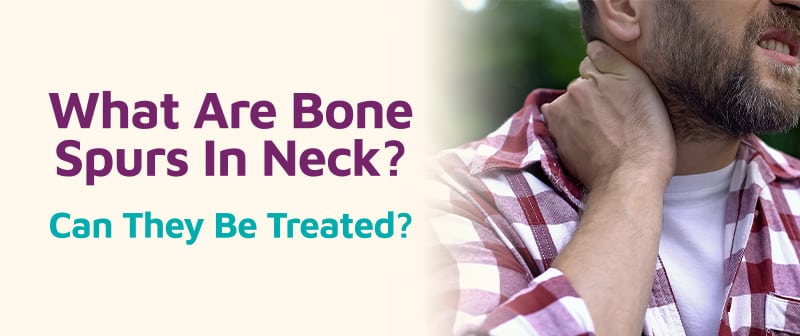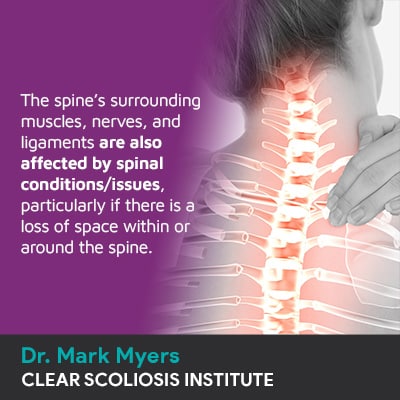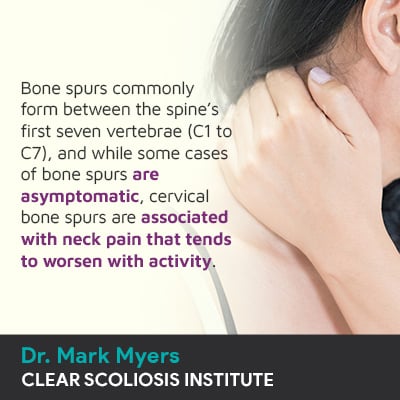
Bone spurs make affected bones larger than normal, and the excess space used by the bony overgrowth is taken from somewhere. If a bone spur forms on the spine, it can cause issues related to nerve compression, and where along the spine a bone spur is located will determine its effects. Continue reading to learn what effects are associated with bone spurs in the neck.
Bone is living tissue, and bone spurs are excess bony overgrowths that develop on bones, bone edges, and/or where bones meet, in and around the joints. Bone spurs in the neck are bony projections that grow on the vertebral bodies of the cervical spine. Bone spurs are also known as osteophytes.
To better understand the effect of bone spurs on spinal health and function, let’s first take a look at the spine’s basic structure.
The spine is one long structure with different sections and many moving parts; the lumbar spine refers to the lower back, the thoracic spine includes the middle/upper back, and the cervical spine refers to the neck.
Each spinal section consists of a stack of vertebrae (bones) that are separated by intervertebral discs, and each section has a characteristic curvature type, and the health of each spinal section depends on the health of the others.

The spine’s natural curves help preserve spinal health by making it stronger, more flexible, and better able to handle mechanical stress; in fact, there are a number of spinal conditions a person can develop that involve a loss of its healthy curves, like scoliosis.
The spinal cord within also contains the 31 pairs of spinal nerves, and as the brain and spinal cord work together to form the central nervous system, spinal conditions can affect the body in many different ways.
The spine’s natural design is based on movement, so the structures of the spine have to work and move together, but if an issue develops that changes that level of movement or space within the spine, problems can occur.
The spine’s surrounding muscles, nerves, tendons, and ligaments are also affected by spinal conditions/issues, particularly if there is a loss of space within or around the spine.
Osteophytes are bony overgrowths that project from bones, the edges of bones, or in and around the joints: where bones meet.
Bone spurs can develop throughout the body, but are commonly found in the hands, feet, shoulders, hips, knees, and spine.
When bone spurs form in the spine, they commonly form between vertebral bodies, and this is associated with stiffness and pain; if a nerve in the spinal column is affected, back pain, and pain that radiates into the extremities, due to nerve compression, are common.
Bone spurs commonly form between the spine’s first seven vertebrae (C1 to C7), and while some cases of bone spurs are asymptomatic, cervical bone spurs are associated with neck pain that tends to worsen with activity.
In addition, headaches, a loss of mobility in the neck, and pain that radiates into the arms due to nerve compression can also be common.

In some cases, excessive rates of spinal deterioration are due to the presence of a degenerative disease such as osteoarthritis.
Osteoarthritis involves the erosion of protective cartilage that enables the smooth gliding motion of joints, and when a bone is damaged, the spine can respond by forming new growths of bone along bone edges, or in and around the joints.
Other times, the body responds to spinal instability by forming an excess of bone on a joint in an attempt to make it larger and more stable, particularly when joint surfaces have been damaged due to spinal conditions and/or arthritis; a potential negative effect of this, however, is that the extra bone can cause new issues by impinging on a nearby spinal nerve.
Bone spurs can also form due to spinal trauma and/or the cumulative effect of certain lifestyle factors such as chronic poor posture, carrying excess weight, or repeatedly lifting heavy objects incorrectly and straining the spine.
Spinal conditions that are linked to the development of cervical bone spurs are:
Spinal stenosis involves the narrowing of the space within the spine, and this puts pressure on the spinal cord and most often affects the lumbar and cervical spinal sections.
As touched on earlier, intervertebral discs sit between adjacent vertebrae, and they perform many key roles: providing structural support (vertebral bodies attach to the disc in between), cushioning that prevents friction during movement, flexibility, and absorbing shock incurred during activity.
Degenerative disc disease is a contributing factor in the development of a number of spinal conditions/issues due to how integral the discs are in preserving optimal spinal function and health.
Spondylosis isn’t a condition itself, but refers to symptoms of back pain due to excessive spinal degeneration, often caused by osteoarthritis (tissues in joints breaking down over time)
Whenever there is loss of motion in a vertebra or joint, this will lead to degenerative changes in the body of the bones, joints, and/or discs between the vertebrae.
The spine was designed to last without degenerating. CLEAR Scoliosis Institute doctors can often estimate how long ago different traumas happened based on the amount of degenerative changes we see in the discs, bones and joints of the spine.
The cervical spine has to support the weight of the head and enable flexibility in the neck, so it can be vulnerable to degenerative changes.
Treatment plans for bone spurs need to be customized around key patient/condition factors such as forward head posture, loss of the cervical curve, and determining how long ago different traumas have built up in the spine and have been left untreated.
When bone spurs are asymptomatic, which is common, it’s not unusual for them to be detected during an X-ray for another issue, but when/if a bone spur becomes symptomatic, treatment can be necessary.
At the CLEAR Scoliosis Institute, we offer a conservative non-surgical treatment approach, and treatment plans are designed around a condition’s underlying cause; once a cervical bone spur’s causation is determined, treatment plans can be designed accordingly.
I provide my patients with non-surgical treatment because this is what, I feel, gives them the best possible quality of life; it’s a non-invasive and safe form of treatment that complements the spine’s natural design and function.
Through chiropractic care, I can address any areas of vertebral subluxation that could be contributing to spinal degeneration and/or the development of other spinal conditions in the neck.
If the presence of an underlying spinal condition has caused the development of a cervical bone spur, it has to be the focus of treatment, as the bone spur has developed as a symptom and/or related complication.
Conservative treatment integrates multiple treatment disciplines into the design of customized treatment plans, which can also include:
While many bone spurs remain asymptomatic and are discovered accidentally, if a bone spur starts to affect a bone’s surrounding tissue, it can cause pain, limb weakness, and a reduced range of motion and joint stiffness in the affected area.
Bone spurs can develop anywhere in the body, including the hands, feet, and spine; they can develop in any of the spine’s sections, but are most commonly found in the lumbar and cervical spinal sections.
The lumbar spine can experience excessive rates of degeneration because it has to support the weight of the entire trunk, the spinal sections above, and feels the effects of bending, lifting, and twisting movements.
The cervical spine is important because it acts as the bridge between the brain and the rest of the body, and the neck has to support the weight of the head and facilitate its ability to turn from side to side and look up and down.
If a cervical bone spur isn’t impinging on a nearby nerve, it’s unlikely to cause noticeable symptoms like neck pain, radiating pain into the extremities, and a reduced range of motion, but if a bone spur is encroaching on space needed for the spinal nerves to function within, it can become problematic.
Depending on causation, severity, and experienced symptoms, conservative non-surgical treatment for bone spurs in the neck can include chiropractic care, physical therapy, and a variety of therapies, rest, and lifestyle guidance.
Here at CLEAR, cervical bone spurs are treated proactively by first determining their underlying cause and then designing a customized treatment plan around it.

CLEAR provides a unique and innovative way of understanding scoliosis. Sign up to receive facts and information you won’t find anywhere else.
